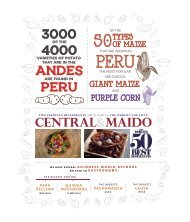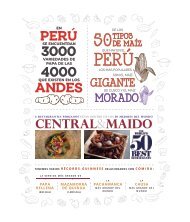UJ #17 - Traditional Peru
You also want an ePaper? Increase the reach of your titles
YUMPU automatically turns print PDFs into web optimized ePapers that Google loves.
Renzo Tasso / PromPerú<br />
<strong>Peru</strong>’s navy – since 1879, when Abelardo Gamarra<br />
Rondo decided to change it from the already existing<br />
name, chilenas.<br />
Different<br />
communities<br />
come together<br />
to form part<br />
of the event.<br />
Pictured, a<br />
Chinese dragon<br />
making its way<br />
through the<br />
streets.<br />
organized by the club committee.<br />
Over the course of the festival, this representative dance<br />
is celebrated and the best dance couples in the country<br />
come together in Trujillo – ‘the capital of the marinera –<br />
to compete for recognition. Another traditional activity<br />
that comes into the spotlight during the festival is that<br />
of the <strong>Peru</strong>vian paso horse, when hundreds of people<br />
gather to watch these graceful creatures glide across<br />
fields, showing off their unique gait.<br />
In Trujillo, there is something for everyone: history,<br />
dance, beaches, and tradition. You wont regret visiting<br />
this incredible city, experiencing its glorious culture, and<br />
exploring its endless opportunities.<br />
Besides the decorated floats and the gorgeous beauty<br />
queens, there is another feature of this festival that gets<br />
a lot of attention: the talented baton twirlers. These<br />
women come each year from the United States, to delight<br />
the audience with their choreography and acrobatic<br />
movements – a tradition that began back in 1965.<br />
Renzo Tasso / PromPerú<br />
Beyond festivities, however, the International Spring<br />
Festival is also a chance for people to connect with the<br />
local culture. There are many activities that are offered<br />
parallel to the parade, which include: conferences,<br />
meetings with authors, painting and signing competitions,<br />
art exhibitions, film festivals, fashion shows, and much<br />
more.<br />
One cannot speak of Trujillo, however, without mentioning<br />
its most representative dance: the marinera. Couples<br />
come together in an elegant, flirtatious choreography<br />
with notably agile footwork, using a handkerchief and a<br />
hat to mark their moves. This captivating and cheerful<br />
dance has gone by the name marinera – inspired on<br />
TR<strong>UJ</strong>ILLO IS ALSO KNOWN FOR ITS<br />
WONDERFUL CUISINE. CEVICHE,<br />
SHAMBAR, AND ‘THEOLOGICAL’ SOUP ARE<br />
SOME OF ITS MOST POPULAR DISHES.<br />
The indispensable Marinera dancers<br />
showing off their elegant moves.<br />
61

















